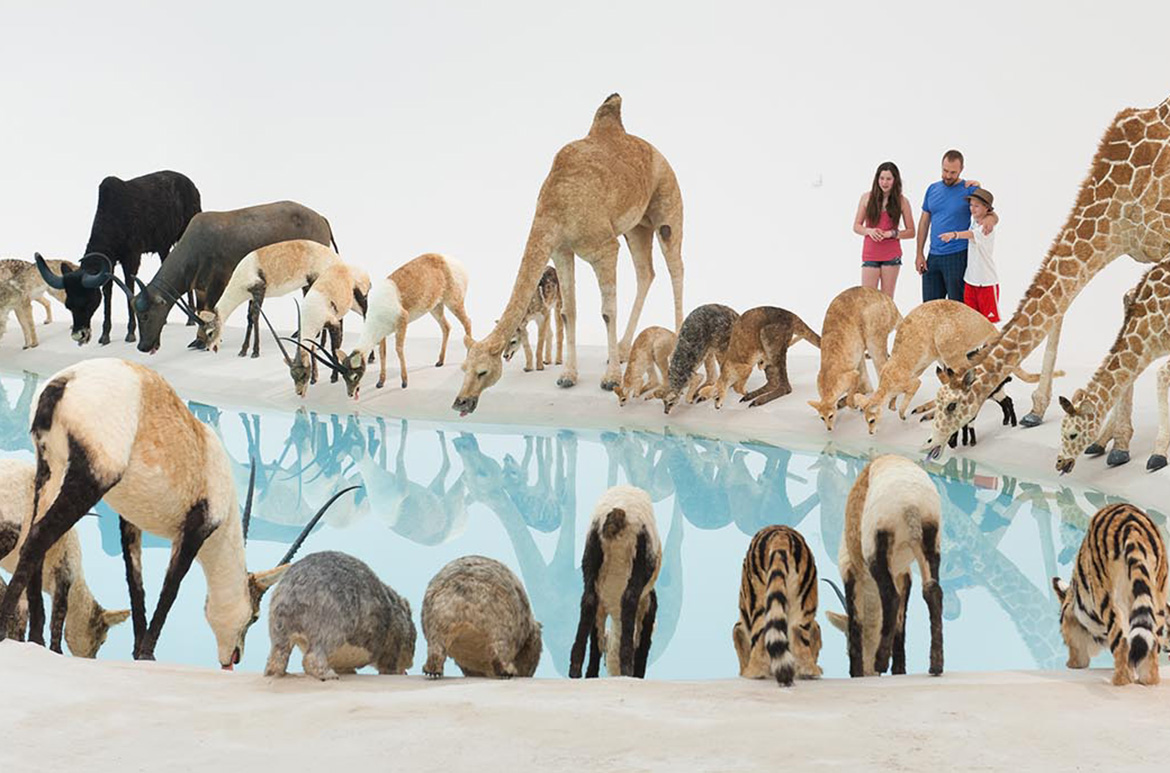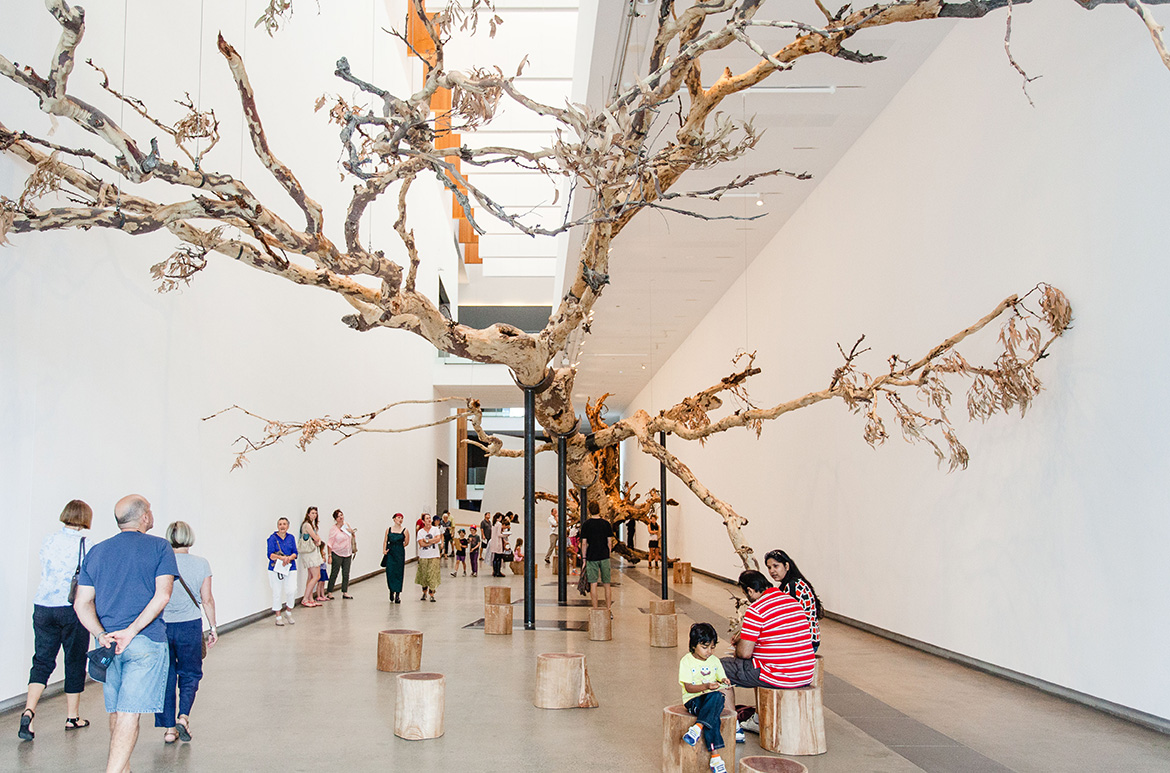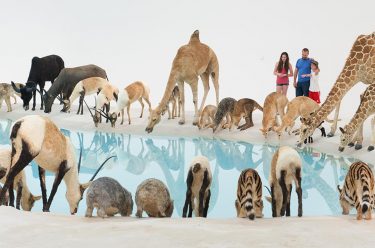The Gallery of Modern Art’s (GOMA) major summer exhibition for 2013 is ‘Cai Guo-Qiang: Falling Back to Earth’ — spectacular installation works across the ground floor of GOMA by renowned New York-based Chinese artist Cai Guo-Qiang — two of which are brand new.
Imagine this: one day you walk into GOMA — and find a watering hole. In the middle of the room, 99 animals are gathered together, drinking: carnivores and herbivores, giraffes and elephants, wombats and kangaroos, and so many more. Stand quietly and you’ll hear a single drop of water as it hits the centre of the pond’s limitless blue, producing ripples across the perfect colour. It would be mesmerising, dislocating, magical. And it’s going to be a reality, thanks to the imagination of Cai Guo-Qiang, one of China’s leading artists. This is Heritage 2013 (illustrated), the centrepiece of ‘Falling Back to Earth’, Cai’s first solo exhibition in Australia.
Heritage has its genesis in a research trip Cai took through Queensland, visiting Lamington National Park and Stradbroke Island, in the winter of 2011. On Stradbroke he saw Brown Lake, a perched lake in the island’s centre. ‘The clear water and the contrast of the sand left a very deep impression on me,’ he says from his base in New York, ‘as did the memory of [children] bathing in the clear water, and how they were playing together’. The idea of these animals ‘putting their differences aside and enjoying and sharing the pond of water together’ is surreal, but Cai sensed it was also a sort of last paradise — ‘which isn’t dissimilar to what most people feel about Australia,’ he adds. ‘At the same time, there are some undercurrents, something sad, if not tragic, that spring from our fears for the future.’
Cai Guo-Qiang ‘Heritage‘ 2013

At 55, Cai stands at the pinnacle of his practice. Recent overseas shows include a major retrospective at the Guggenheim in New York and a new work at Mahtaf: Arab Museum of Modern Art in Qatar. An exhibition mounted for just 15 days at China’s National Art Museum was seen by over 50 000 people, and his signature pyrotechnics featured in the opening and closing ceremonies of the Beijing Olympics, for which Cai directed visual and special effects. Recent creations include Inopportune: Stage One (nine suspended ‘exploding’ cars, held in the Seattle Art Museum collection) and Inopportune: Stage Two (a series of tigers leaping through the air, assaulted by arrows), both 2004; and Head On 2006, a Möbius strip of 99 wolves that hurl themselves at a glass barrier the precise height of the Berlin Wall, stagger as they fall, and limp back to rejoin the loop. A breathtaking work that Cai describes as exploring ‘the endless cycle of heroic and collective acts’, Head On has travelled to Brisbane for ‘Falling Back to Earth’.
Cai Guo-Qiang ‘Bridge Crossing’ 1999

Brisbane audiences are already familiar with Cai: in 1996, for ‘The Second Asia Pacific Triennial of Contemporary Art’ (APT2), he created Dragon or Rainbow Serpent: A Myth Glorified or Feared, a 27-metre series of drawings created by firing gunpowder along paper scrolls and one of Cai’s ‘Projects for Extraterrestrials’. Three years later, he built Bridge Crossing (illustrated) over the Queensland Art Gallery’s Watermall for APT3. Reminded of these earlier projects, Cai laughs with the warmth and exuberance that mark both him and his work. Both exhibitions were scheduled to include public events, neither of which eventuated. ‘In 1996 I proposed an outdoor explosion event about the myth of the rainbow serpent,’ he says,
‘but there was an explosion at the fireworks company, and all my products were gone. In 1999, I proposed another work inspired by the rainbow serpent — 99 zinc boats chained together, filled with alcohol, and lit as they floated along the river. Unfortunately the boats sank before they reached the audience.’ He laughs again. ‘Most institutions would think, “Well, working with this artist, it’s a disaster”. But what I love about GOMA is that their commitment values creativity above all.’
Cai Guo-Qiang ‘Dragon or Rainbow Serpent’ 1996

‘Cai’s work is ambitious and complex — logistically and technically — which means, occasionally, it doesn’t work out, says QAGOMA’s Curatorial Manager of Asian and Pacific Art. ‘We’ve always embraced that, and because of that, there’s a huge amount of trust and goodwill between us. That changes what an artist thinks they can do; it allows them to be more ambitious.’ Ambitious like Cai’s plan to incorporate a 70-metre eucalypt in the show, laid on its side, from roots to canopy. ‘It emphasises his desire to bring his practice literally back to earth, yet there’s still something fabulously open about the way he thinks — it isn’t restricted. He’s like a child, encountering things for the first time.’ As Cai himself says: ‘I’ve always put myself in the place of a child’, and it’s a point of view with particular implications for the faux animals in Heritage. These creatures aren’t just life-size; they’re life-size plus ten per cent, they are bigger than they are — we inflate their proportions in our minds. Perhaps that’s the child in all of us.
Cai remembers: ‘When I saw the first wolves [for Head On], I was surprised at the size — I felt I could just push them over. I asked the artisans, “Is this very small?” and they thought I was falsely accusing them. They said, “This is how big they really are”. But because we as humans fear these animals, and because in nature they move, we usually perceive them as bigger.’ When work began on the animals for Heritage, he says, ‘I went back to the factory and personally carved the styrofoam. The artisans were all complaining: “real animals are not as muscular as you’re trying to make them; and their muscles are covered with fur”. But to me as an artist I want them to be more muscular so they look like they have more power.’
His menagerie of faux-taxidermists in China fashioned zebras, wombats, tigers and a rhino in what will be one of the world’s most surreal incarnations of an ark. At GOMA, the exhibition design team experimented with creating a ‘bottomless’ pool, its water just the right shade of blue and its drip timed to produce precisely the right ripples — all on Level 1 of the Gallery. Not to mention the logistics of the tree.
Ashley Hay is a writer based in Brisbane and spoke with the artist and key Gallery staff.

#QAGOMA


I had some year 5 students do some drawings on paper and using the iPads apps like You Doodle and Explain Everything to create their responses to Cai’s artworks. I shall share Joel’s Explain Everything arranged drawing of ‘Head On”. I put it on Instagram #theartmst_ktyrwhitt
Thanks Kate. We look for forward to seeing them. Regards QAGOMA